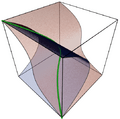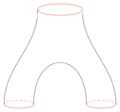Commutative ring facts for kids
A commutative ring is a special kind of mathematical system. Imagine a collection of things, like numbers, where you can add them together and multiply them. This system follows certain rules, much like how regular numbers behave.
One of the most important rules for a commutative ring is that when you multiply two things, the order doesn't matter. For example, if you multiply 2 by 3, you get 6. If you multiply 3 by 2, you also get 6. This is called the commutative property of multiplication.
Another key rule is that multiplication works well with addition. This is called the distributive property. It means if you have three things, say a, b, and c, and you multiply c by the sum of a and b (like c * (a + b)), it's the same as multiplying c by a and c by b separately, and then adding those results (c*a + c*b).
Contents
What is a Ring?
Before we talk about a commutative ring, let's understand what a ring is. In mathematics, a ring is a set of elements where you can do two main things:
- Addition: You can add any two elements in the set, and the result is always another element in the same set.
- Multiplication: You can multiply any two elements in the set, and the result is also always another element in the same set.
These operations also have to follow some specific rules, similar to how addition and multiplication work with numbers you know. For example, there's usually a "zero" element for addition and a "one" element for multiplication.
Examples of Rings
The most common example of a ring is the set of all integers (whole numbers like -3, -2, -1, 0, 1, 2, 3, ...).
- If you add two integers (like 5 + 7), you always get another integer (12).
- If you multiply two integers (like 5 * 7), you always get another integer (35).
- The number 0 is the "zero" element (5 + 0 = 5).
- The number 1 is the "one" element (5 * 1 = 5).
What Makes it "Commutative"?
The word "commutative" comes from "commute," meaning to move around or switch places. In a commutative ring, the order of multiplication doesn't change the answer.
- For any two elements, say x and y, in the ring, x multiplied by y is always the same as y multiplied by x.
- Using integers, 3 * 4 = 12, and 4 * 3 = 12. This shows that integers form a commutative ring.
Not all rings are commutative. For example, multiplying matrices (special grids of numbers used in advanced math) usually depends on the order. So, matrices often form a ring that is not commutative.
Why Are Commutative Rings Important?
Commutative rings are very important in a branch of mathematics called algebra. They help mathematicians study different number systems and understand their properties. They are used in:
- Number theory: Studying the properties of numbers.
- Algebraic geometry: Connecting algebra with shapes and spaces.
- Cryptography: Making and breaking secret codes.
Understanding commutative rings helps us build a strong foundation for more complex mathematical ideas and solve real-world problems.
Images for kids
See also
 In Spanish: Anillo conmutativo para niños
In Spanish: Anillo conmutativo para niños




